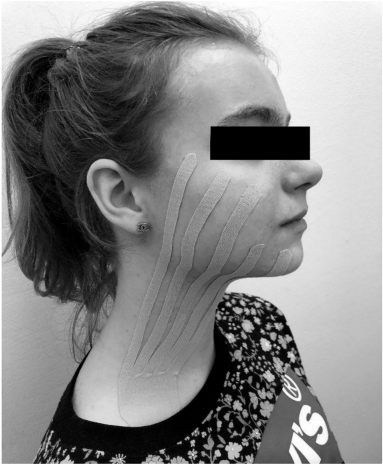An interesting article titled “Kinesio Taping as an Adjunct Therapy in Postoperative Care after Extraction of Impacted Third Lower Molars—A Randomized Pilot Study” appears in the Journal of Clinical Medicine written by Piotr Pławecki and et. al. (2023, 12, 2694). The article seeks to study the effectiveness of kinesio taping when compared with the use of non-steroidal anti-inflammatory drugs (NSAIDs) for treating complications after extraction of an impacted lower wisdom tooth.
In the article the researchers divided 30 participants into two groups: 15 of the participants had tape applied after wisdom tooth extraction while the other 15 did not. Both groups were told to take 100mg of Ketoprofenum (a NSAID). Patients in the study had a lower impacted wisdom tooth extracted for the following reasons: 1) patients without comorbidities, 2) patients with indications for surgery to remove the impacted lower wisdom tooth for orthodontic reasons 3) patients with indications for surgery to remove the impacted lower wisdom tooth for surgical reasons (inflammation/pathological changes), and 3) patients with indications for surgery to remove the impacted lower wisdom tooth for prophylactic reasons. Those that had the tape had it immediately applied after surgery. Those that had the tape were told to not take excessive care and use the tape for at least three days and up to five days. Before sticking the tape, each participants skin was cleaned, degreased, and dried and the tape placed to form a single fan over the area of expected swelling.
This image is from Piotr Pławecki and et. al. ,”Kinesio Taping as an Adjunct Therapy in Postoperative Care after Extraction of Impacted Third Lower Molars—A Randomized Pilot Study,” Journal of Clinical Medicine, 2023, 12, 2694, and has a Creative Commons license.
The participants had their pain assessed using a visual analog scale (VAS) and a caliper was used to measure swelling. These assessments were taken on the first day of surgery, on the second day after surgery, and on the seventh day after surgery. The authors found no stastically signficant difference in maximal mouth opening of the two groups for the day after surgery and the second day after surgery but did find a statistically significant difference (p = 0.0101) on the seventh day after surgery. Those who had the tape applied experienced greater maximal mouth on the seventh day after surgery. The authors found a stastically signficant difference between the two groups for the VAS asssessment of pain on the day after surgery and specifically the group with tape had lower scores. The VAS measurement was not statistically significant at the two other assesstment periods. It was also found that on the first and second day after the surgery, the amount of medication taken was significantly lower in group that had the tape applied.
These findings suggest kinesio taping reduces the use of anti-inflammatory drugs and pain intensity and helps to increase the degree of jaw opening after wisdom teeth surgery. The authors even go as far to say they feel that using such taping should be ia standard in the surgery of impacted lower wisdom teeth. In the future they hope to educate more people on the effectiveness of kinesio taping and use them for future studies. It is noted that the study had several limitations such as the small sample size and not including an equal amount of men and women in the two study groups. This is not the first study or time that kinesio taping has been discussed on this site, see the post Kinesiology Taping Following Wisdom Teeth Removal.

